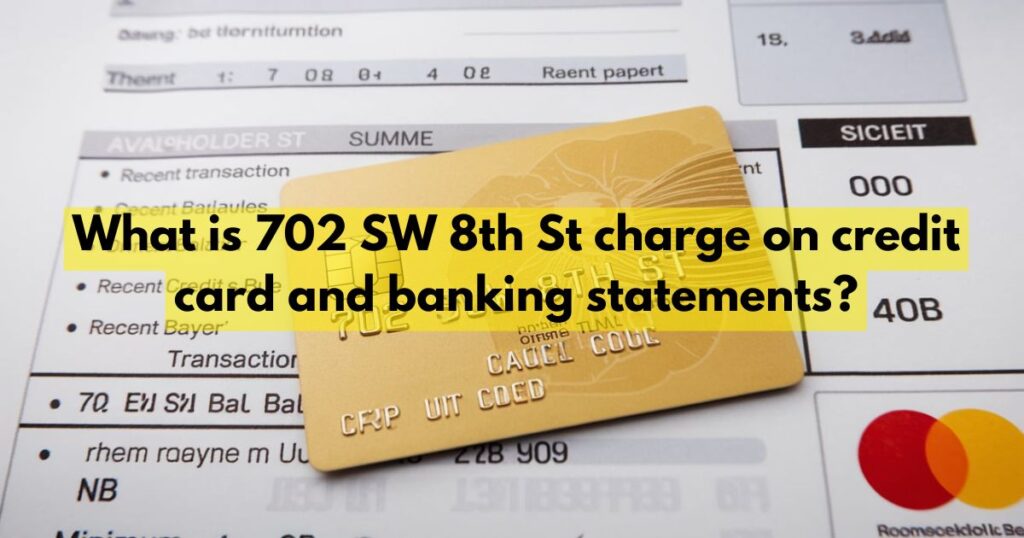Ever glanced at your credit card statement and felt your heart skip a beat? You’re not alone. Millions of Americans have scratched their heads over a mysterious charge labeled “702 SW 8th St.” But fear not! We’re about to embark on a journey to demystify this enigmatic entry and put your mind at ease.
The Mystery of the Unexpected Charge
Picture this: You’re sipping your morning coffee, scrolling through your bank statement, when suddenly, you spot it. A charge from “702 SW 8th St” that you don’t remember making. Your brain goes into overdrive. Was your card stolen? Did you sleepwalk and go on a shopping spree? Before you spiral into financial panic, take a deep breath. The truth is much simpler and far less dramatic than you might think.
This mysterious charge has been causing quite a stir across the USA. From New York to California, folks have been scratching their heads, wondering what on earth this address could be. It’s like a nationwide game of financial Clue, and we’re about to solve it together.
Unveiling the Truth: What is the 702 SW 8th St Charge?
Drumroll, please… The big reveal is here! That perplexing “702 SW 8th St” charge? It’s none other than Walmart’s corporate headquarters in Bentonville, Arkansas. Yep, you read that right. The retail giant’s mothership is the source of this head-scratching charge.
But why is Bentonville, Arkansas popping up on your statement instead of your local Walmart? Well, it’s all part of Walmart’s grand financial strategy. By centralizing their billing, they’re able to keep a tighter rein on their vast financial empire. It’s like having one giant piggy bank instead of thousands scattered across the country.
The Method Behind the Madness: Walmart’s Billing Practices
Walmart’s centralized billing system is like a massive financial funnel. Every purchase, whether you’re buying socks in Seattle or sunscreen in Miami, gets processed through their headquarters in Bentonville. It’s a bit like how all roads once led to Rome – in Walmart’s world, all transactions lead to Arkansas.
This system has its perks and quirks for consumers. On the plus side, it makes tracking your Walmart purchases a breeze. See a “702 SW 8th St” charge? You know it’s Walmart. On the flip side, it can be confusing if you’re not in the know. But hey, that’s why we’re here, right?
When Might You See a 702 SW 8th St Charge?
So, when might this mysterious charge pop up on your statement? Let’s break it down:
- In-store purchases: That quick run for milk and eggs? Yep, it could show up as 702 SW 8th St.
- Online shopping sprees: Clicked “add to cart” on Walmart.com? Hello, Bentonville charge!
- Subscription services: Signed up for Walmart+? That recurring charge will likely bear the famous address.
Remember, whether you’re pushing a cart down the aisle or clicking through the virtual store, all roads (or in this case, all charges) lead to Bentonville.
Decoding Your Statement: Is This Charge Legit?
Now, let’s play financial detective. How can you be sure that 702 SW 8th St charge is legit? Time for some DIY sleuthing:
- Match charges to purchases: Dig out those receipts and play “match the amount.”
- Online account investigation: Log into your Walmart.com account and check your order history.
- Timing is everything: Does the charge date align with your last Walmart run?
If everything lines up, congratulations! You’ve solved the case. But if something seems fishy, it’s time to dig deeper.
What to Do If You Don’t Recognize the 702 SW 8th St Charge?
If you’ve done your detective work and still can’t place the charge, don’t panic. Here’s your step-by-step guide to getting answers:
- Keep calm and carry on: Take a deep breath. False alarms are more common than actual fraud.
- Contact Walmart directly: Their customer service team can help track down the charge.
- Reach out to your bank: If Walmart can’t help, your bank’s fraud department is your next stop.
Remember, it’s always better to be safe than sorry when it comes to your hard-earned cash.
Protecting Your Wallet: Preventing Unexpected Charges
An ounce of prevention is worth a pound of cure, especially when it comes to your finances. Here are some tips to keep your wallet safe:
- Statement vigilance: Make checking your statements a habit, like brushing your teeth.
- Set up alerts: Let technology be your financial watchdog with push notifications.
- Use secure payment methods: Think of it as putting a force field around your money.
By staying proactive, you can catch any truly suspicious activity before it becomes a big problem.
The History Behind the Address
Ever wonder why Walmart chose Bentonville, Arkansas as its headquarters? It’s a tale as American as apple pie. Sam Walton, the retail wizard behind Walmart, opened his first store in Rogers, Arkansas, just a stone’s throw from Bentonville. As his empire grew, he decided to keep his roots firmly planted in the Natural State.
The 702 SW 8th St address isn’t just a corporate headquarters it’s a piece of retail history. It’s where business decisions that affect millions of shoppers are made every day. So when you see that charge on your statement, you’re not just seeing a transaction – you’re seeing a slice of American business lore.
The Tech Behind the Charge
In this digital age, you might wonder how Walmart manages to funnel millions of transactions through one address. The answer? Some seriously impressive tech.
Walmart’s centralized billing system is a marvel of modern computing. It processes countless transactions every second, from physical stores, online orders, and services like Walmart+. This system allows Walmart to:
- Track inventory across thousands of stores
- Analyze shopping trends in real-time
- Detect and prevent fraud more efficiently
It’s like having a super-computer dedicated to keeping your shopping experience smooth and secure. Pretty neat, huh?
The Impact on Small Businesses
Walmart’s centralized billing doesn’t just affect individual consumers it has ripple effects across the business world. For small businesses that sell products through Walmart, this system can be both a blessing and a challenge.
On the plus side, it simplifies their accounting. All transactions come from one source, making bookkeeping a breeze. However, it can also make it harder to track which products are selling in which locations. It’s a trade-off that small business owners have to navigate in the world of big-box retail.
Global Implications of Centralized Billing
While we’ve focused on the USA, Walmart’s reach extends far beyond American borders. The 702 SW 8th St charge might pop up on statements around the world, from Canada to China.
This global presence raises interesting questions about international finance and corporate structure. How does one address in Arkansas become a focal point for global retail? It’s a testament to the power of modern commerce and the reach of American business.
Tips for Efficient Statement Management
Now that you’re a pro at spotting Walmart charges, here are some tips to keep your financial life organized:
- Create a budget category for Walmart: This can help you track your spending at this retail giant.
- Use digital tools: Many banking apps allow you to add notes to transactions. Tag your Walmart purchases for easy reference.
- Keep digital receipts: Walmart offers e-receipts. Save them in a dedicated folder for easy comparison with your statement.
- Set spending alerts: Many banks allow you to set alerts for charges over a certain amount. This can help you catch any unusually large Walmart purchases.
The Bigger Picture: Financial Literacy
Understanding the 702 SW 8th St charge is just one piece of the financial literacy puzzle. In today’s complex economic landscape, being able to read and understand your financial statements is a crucial skill.
Consider taking a financial literacy course or using free online resources to boost your money management skills. The more you know, the better equipped you’ll be to make informed financial decisions.
Read Also: Unlocking the Future: Why is Foresight Not Getting Traction with Business?
Frequently Asked Questions
What are the charges on a credit card statement?
Credit card statements typically show purchases, cash advances, balance transfers, fees, and interest charges. These charges reflect your spending and account activity for the billing period. Each entry usually includes the date, merchant name, and transaction amount.
How do I identify a charge on my credit card?
To identify a charge, look at the transaction date, merchant name, and amount on your statement. Cross-reference these details with your receipts or purchase history. If you’re still unsure, many card issuers provide additional transaction details online or through their mobile app.
What is the charge for credit card transactions?
Credit card transaction charges, also known as processing fees, are typically paid by merchants, not cardholders. These fees usually range from 1.5% to 3.5% of the transaction amount, depending on the card type and merchant agreement. Consumers generally don’t see these fees directly.
What are credit card default charges?
Credit card default charges are penalties imposed when you violate your cardholder agreement, typically by missing payments. These can include late payment fees, over-limit fees, and increased interest rates. Default charges are meant to discourage late payments and compensate the issuer for increased risk.
Conclusion
And there you have it, folks! We’ve cracked the code of the 702 SW 8th St charge. It’s not a mysterious entity or a sneaky scammer – it’s just good ol’ Walmart, processing your purchases from their Arkansas HQ.
Remember, knowledge is power, especially when it comes to your finances. By understanding what this charge means, you’re better equipped to manage your money and spot any truly suspicious activity.
So the next time you see “702 SW 8th St” on your statement, you can nod knowingly and say, “Ah yes, my old friend Walmart.” Happy shopping, and may all your mysterious charges be easily solved.





